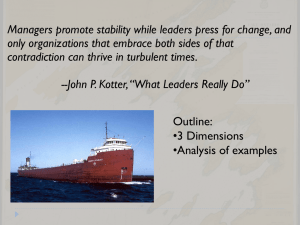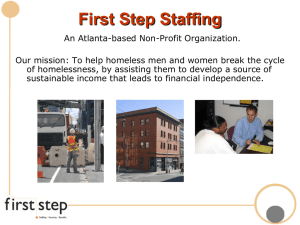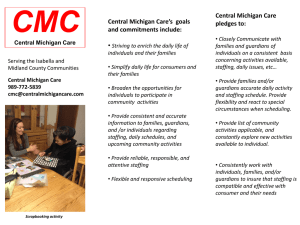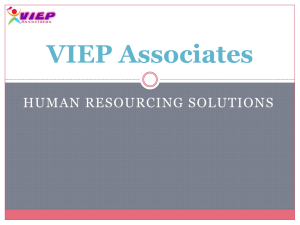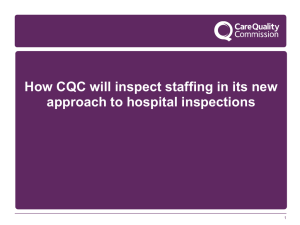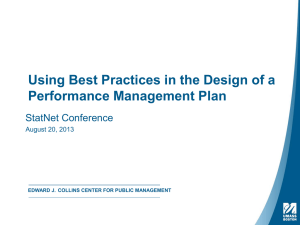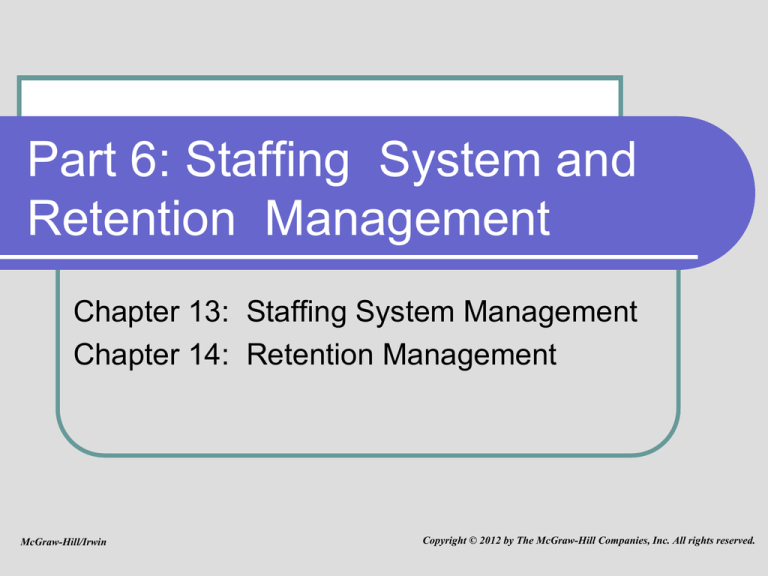
Part 6: Staffing System and
Retention Management
Chapter 13: Staffing System Management
Chapter 14: Retention Management
McGraw-Hill/Irwin
Copyright © 2012 by The McGraw-Hill Companies, Inc. All rights reserved.
Part 6: Staffing System and
Retention Management
Chapter 13: Staffing System Management
13-2
Staffing Organizations Model
Organization
Mission
Goals and Objectives
Organization Strategy
HR and Staffing Strategy
Staffing Policies and Programs
Support Activities
Core Staffing Activities
Legal compliance
Planning
Recruitment:
Selection:
External, internal
Measurement, external, internal
Job analysis
Employment:
Decision making, final match
Staffing System and Retention Management
13-3
Chapter Outline
Administration of
Staffing Systems
Organizational
Arrangements
Jobs in Staffing
Policies and
Procedures
Human Resource
Information Systems
Outsourcing
Evaluation of Staffing
Systems
Staffing Process
Staffing Process Results
Calculating Staffing
Metrics
Customer Satisfaction
Legal Issues
Record Keeping and
Privacy
EEO Report
Legal Audits
Training for Managers
and Employees
Dispute Resolution
13-4
Learning Objectives for This
Chapter
Recognize the importance of effective policies and
procedures for staffing
Understand the importance of concrete, fair policies
and procedures in selection
Evaluate the advantages and disadvantages of
outsourcing staffing processes
Understand how to evaluate the various results of
staffing processes
Develop metrics for the measurement of staffing
systems
Recognize the legal issues involving record keeping
and applicant/employee privacy
Plan for effective dispute resolution
13-5
Discussion Questions for This
Chapter
What are the advantages of having a centralized staffing function,
as opposed to letting each manager be totally responsible for all
staffing activities in his or her unit?
What are examples of staffing tasks and activities that cannot or
should not be simply delegated to a staffing information system
for their conduct?
What would be the advantages and disadvantages of outsourcing
the entire staffing system to a vendor?
In developing a report on the effectiveness of the staffing process
being conducted for entry-level jobs, what factors would you
address and why?
How would you try to get individual managers to be more aware
of the legal requirements of staffing systems and to take steps to
ensure that they themselves engage in legal staffing actions?
13-6
Administration of Staffing Systems
Organizational arrangements
Jobs in staffing
Policies and procedures
Human Resource Information Systems
Outsourcing
13-7
Organizational Arrangements
Refers to how the organization structures itself
to conduct human resources and staffing
activities
Research results
Employment and recruitment are increasingly
important components of HR systems
Staffing receives a greater percentage of total HR
budget than other functions -- 20% of total budget
Exh. 13.1: Example of HR Department
and Employment (Staffing) Function
13-8
Jobs in Staffing
Entry occurs as specialist in recruiting and
interviewing
Mobility may involve both traditional and
nontraditional career tracks
Jobs are becoming more customer focused
and facilitative
Increasing numbers of jobs are found in
staffing firms
New type of job -- Chief Talent Officer or VP
for Talent Acquisition
Exhs. 13.2 and 13.3: Staffing Jobs
13-9
Policies and Procedures
Indicate desirable courses of action
and steps to implement action
Policy
Procedure
Guiding principle or objective
sought through appropriate actions
Prescribed steps of acting in similar situations
Exh. 13.4: Staffing Topics in
CompuServe’s HR Policy Manual
13-10
Technology
Staffing activities generate considerable
information
Small organizations still use paper-based
forms, but increasingly have access to
HRIS programs and web-based
applications
Increased use of HRIS means
Increased accountability for HR activities
Ability to streamline processes
13-11
Ex. 13.5 Human Resources Information
Systems for Staffing Tasks
13-12
Ex. 13.5 Human Resources Information
Systems for Staffing Tasks
13-13
Outsourcing
Refers to contracting out work to a vendor or
third-party administrator
Outsourcing of HR functions is increasing
Types of staffing activities outsourced
Use of temporary employees, executive search,
drug testing, skill testing, background checks, job
fairs, employee relocation, assessment centers,
and affirmative action planning
Strategic and operating reasons to outsource
Expertise, flexibility, time savings, service quality,
reduction of legal liability, and cost reduction
13-14
Ex. 13.6 Comparing Outsourced vs.
In-House Staffing
13-15
Discussion Questions
What are the advantages of having a
centralized staffing function, as opposed to
letting each manager be totally responsible for
all staffing activities in his or her unit?
What are examples of staffing tasks and
activities that cannot or should not be simply
delegated to a staffing information system for
their conduct?
What would be the advantages and
disadvantages of outsourcing the entire
staffing system to a vendor?
13-16
Evaluation of Staffing Systems
Staffing process
Staffing process results
Staffing costs
Customer satisfaction
13-17
Staffing Process
Concept
Establishes and governs the flow of employees into, within,
and out of the organization
Reasons to use a well-planned staffing system
Ensures same KSAO information is gathered from all
applicants
Ensures all applicants receive same information
Enhance applicants’ perceptions of procedural fairness of
staffing system and decisions
Less likely to generate legal challenges by applicants
Provides a clear picture of where deviations have occurred
13-18
Staffing Process Results
Quantitative indicators indicate effectiveness
and efficiency of staffing system
Exh. 13.7: Staffing Process Results Evaluation
Flowchart
13-19
Staffing Metrics
Staffing metrics are useful barometers to
gauge pulse of staffing flow
Provide objective, “bottom line” results
Useful for comparative purposes
Split sample techniques
Longitudinal analysis
Compare to benchmarks
13-20
Ex. 13.8 Common Staffing Metrics
13-21
Calculating Staffing Metrics: Examples
Number of positions filled
Time-to-fill openings
the number of days it takes for a job requisition to
result in a job acceptance by a candidate.
Hiring cost estimates
count of the number of individuals who accepted
positions during the fiscal year.
sum of advertising, agency fees, employee
referrals, travel costs for applicants and staff,
relocation costs, and pay and benefits for recruiters
Staffing cost or efficiency ratio
total staffing costs/total compensation recruited
13-22
Customer Satisfaction
Managers
Questions focus on elements like communication,
timeliness, candidate quality, test quality, and
service focus
Ex. 13.1 Examples of Survey Items for Assessing
Manager’s Satisfaction With Staffing Services
Job Applicants
Questions focus on communication, perceived
fairness of the system, and opinion of the
organization as a whole
Ex. 13.12 Sample Job Applicant’s Satisfaction
Survey Questionnaire
13-23
Discussion Questions
In developing a report on the
effectiveness of the staffing process
being conducted for entry-level jobs,
what factors would you address and
why?
13-24
Legal Issues
Record-keeping, privacy, and reports
EEO Report
Legal Audits
Training
Dispute resolution
13-25
Legal Issues
Record keeping, privacy, and reports
Creation and maintenance of records
Four purposes of records
Exh. 13.13: Federal Record-Keeping Requirements
Privacy concerns
Preparation of reports
Exh. 13.14: Employer Information Report EEO-1 Form
Audits
13-26
Dispute Resolution
Negotiation
Fact finding
Employees and managers work together in a panel
Mediation
Neutral person investigates complaint
Peer review
Discuss complaint with goal of resolving it
Neutral person helps to find a solution
Arbitration
Neutral person makes a decision binding on the
parties
13-27
Discussion Questions
How would you try to get individual
managers to be more aware of the legal
requirements of staffing systems and to
take steps to ensure that they
themselves engage in legal staffing
actions?
13-28
Ethical Issues
Issue 1
It has been suggested that the use of staffing
technology and software is wrong because it
dehumanizes the staffing experience, making it
nothing but a mechanical process that treats
applicants like digital widgets. Evaluate this
assertion.
Issue 2
Since there are no standard ways of creating
staffing process results and cost metrics, is there a
need for some sort of oversight of how these data
are calculated, reported, and used within an
organization? Explain.
13-29




